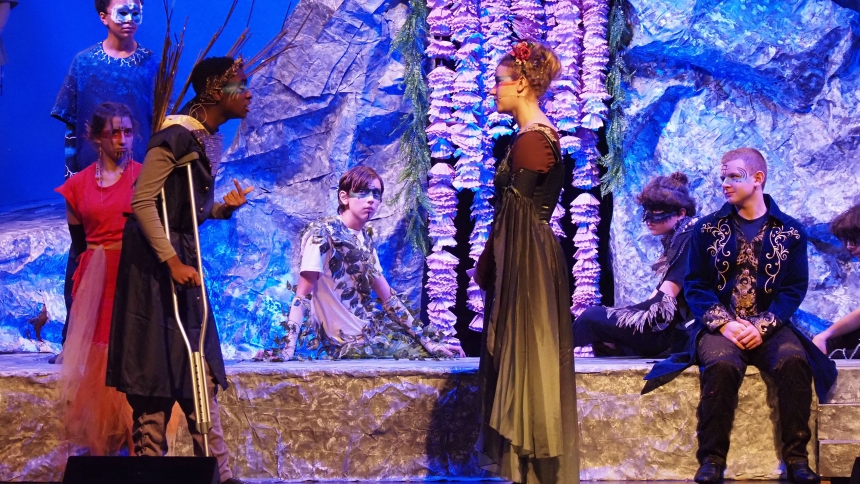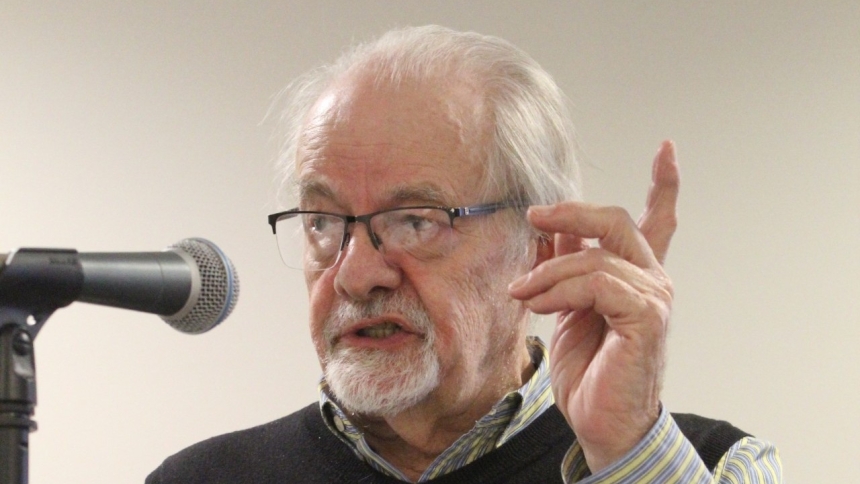
GARY – The adage “standing on the shoulders of giants” may have originally connoted the building upon great intellectual developments. Expanded to indicate a cultural transfer of faith, many at a gathering celebrating the contributions of black Catholics in the U.S. spoke with great love of their ancestors and for the people in their lives.
At the Mass in honor of Black Catholic History Month on Nov. 17, the faithful assembled for worship and fellowship at the Cathedral of the Holy Angels. Members of the cathedral choir projected soaring voices in liturgical music and praise hymns filling the transepts and nave.
“It was beautiful, it was rather nice,” said Clem Parker, who turned 90 on Nov. 7. “This has been my church ever since my kids went to school at (Holy Angels).”
Teresa Samuel-Hayes, originally of East Chicago but now a Gary resident, added, “I loved it and I hope they continue having Mass like this.”
Generations of Catholics and people of different ethnic and racial backgrounds joined in the liturgy. Some like Deshaun Harris, 16, arrived to assist with service at the altar. The Andrean High School junior is a parishioner at St. Mary of the Lake, where he grew up under the mentorship of Bishop Dale J. Melczek, a beloved pastor as bishop emeritus.
Though the liturgy, gathering and month-long celebration focus on the Catholic identity of African Americans, Harris said that in his day-to-day life, he doesn’t distinguish among people by their external appearances, but more the content of their character.
“If people don’t get along it’s probably trouble with their faith and they may be going through things that they don’t talk about,” said Harris. “I have friends of every race, so I’ll talk to everyone; I really don’t look at people any differently.”
Youth from Bishop Noll Institute were also represented at the Mass. One BNI mother was very proud of her youngest son, who lectored from Daniel 12:1-3.
Sinee West said 17-year-old BNI junior Akinjide Olaoye’s participation in the sacramental life is part of a thread of Catholicism that runs through their family.
“He’s been in the Catholic church all his life, so it’s second nature, it’s just he was on the altar side,” said West, who, with her family, are members of St. John Bosco in Hammond.
For Olaoye’s part, he welcomed the opportunity to be a lector before the large congregation, an invitation to students from Father Michael Surufka, cathedral pastor and rector.
“When I was doing my practice reading, I noticed I wasn’t nervous … so when I went up, I was thinking that this is just another reading, and I’ve been reading since elementary school,” he explained.
The 2018 National Opinion Research Center General Social Survey reported 76.6 million Catholics, or 23% of the U.S. population, which, by far, is the largest single Church representation in the nation. According to Pew Research Center, 3% of U.S. Catholics identify as black.
Olaoye said as a minority within the Church, the day’s gathering was empowering. “I think it’s always nice to see the Church come together. There’s not a lot of black Catholics around, so when we set aside a time to commemorate all of them and we see how much (history) there is, I feel that’s very nice to witness.”
Educational components of the liturgy and fellowship meal that followed included historical perspectives ranging from the timeline of figures such as St. Augustine, born in North Africa in 354 A.D., to the conversion of a Pentecostal leader and his entire congregation to the Catholic Church in recent times.
Calling the cultural connections made in the sacred space “a brilliant exchange of gifts,” Bishop Robert J. McClory continued with his homily describing how his ministerial experiences helped give him perspective on varied experiences of black faithful.
Bishop McClory told about a 2003 mission trip to Uganda, when he was a parish priest, with Deacon Alex Jones, a Protestant Pentecostal church leader from Detroit.
“As (Deacon Jones) continued to reflect more deeply on the early Church and the celebration of the Mass, he began to see the history and richness of the Catholic Church and his heart and his mind were so moved that he came to the point of wanting to become Catholic,” he said. “So, he brought his congregation into the Church as they came to receive and accept the beauties of the Church.”
He added, “I’m so glad I could experience it through his eyes, those of a black Catholic.”
The bishop also spoke about the pioneering black newspaperman Daniel Rudd, whose communication ministry brought much context to the state of the American church starting in 1885.
The legacy of such pioneering believers relates to the promises from the day’s readings, the bishop said, referencing the Book of Daniel: “The wise shall shine brighter, like the splendor of the firmament.”
“And so, we have to address the challenges we have today – we’re not a perfect Church. But we have some beautiful stars to reflect upon and celebrate,” proclaimed Bishop McClory.
In the cathedral school gymnasium, Deacon Martin Brown provided a historical timeline of the contributions of those of African heritage in the Church. He showed early growth in Christendom and the times of bondage when some European powers participated in the slave trade. He also showed, in historic chronology, the Church’s evolving pronouncements about the enslavement of people.
Highlights of the post-Civil War era included the ordination of the first African-American bishop, Father James Augustine Healy, in 1875 and the ordination of Augustus Tolton, the first “recognizable black priest in the U.S.” The first Colored Catholic Congress was held in 1889 in Washington, D.C. and was coordinated by Rudd.
Though the event to honor Black Catholic History Month is an annual gathering, Deacon Brown said he encourages the faithful to avail themselves of any opportunity to “dig in and take a deeper look” at the history and context of the Church.
“This is the richness of our faith. The focus of this presentation is Africans, but, you know, black priests that were being ordained were by white bishops … it’s the universality of the Church.”
Caption: Members of the Tameka Freeman (top) family pray during Mass, which preceded a fellowship gathering on Nov. 17 at the Cathedral of the Holy Angels in Gary. The event called to mind the designation by the Church of Black History Month, when since 1990, U.S. faithful have joined together in worship, education, charity and entertainment to recognize heritage of Africa and the African Diaspora in the Catholic Church. (Anthony D. Alonzo photo)



